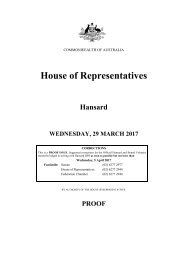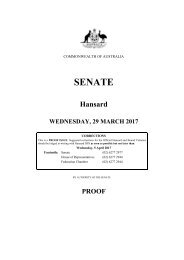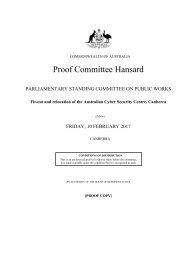SENATE
2e7N9wg
2e7N9wg
Create successful ePaper yourself
Turn your PDF publications into a flip-book with our unique Google optimized e-Paper software.
88 <strong>SENATE</strong> Thursday, 13 October 2016<br />
As we all know, the fire triangle is one of fuel, oxygen and a source of ignition. We can assume, therefore, that,<br />
by the time firefighting foam and water are being used, we have already had the oxygen and we have already had<br />
the source of ignition—and we have fuel. So the purpose of firefighting foam is to add to the effectiveness of<br />
water by creating, at the microscopic level, a capacity to be able to starve the fuel of air—oxygen—in which case,<br />
of course, it does not burn.<br />
I just want to make some comments with regard to the process and those who appeared before us in the<br />
hearings we have had and to also speak of the actions being coordinated by the Minister for Health and Aged Care<br />
and the Minister for Defence.<br />
With my veterinary hat from earlier days on, I put a question doctors in Newcastle. What we would normally<br />
expect to have happen is that a doctor might find a number of cases for which they have no clinical explanation,<br />
and that would usually cause them to talk to other doctors in their clinic and their practice and say to them: 'Look,<br />
I think I am seeing an unusual set of circumstances. Are you also seeing it?' Those other clinicians might say,<br />
'Yes, as a matter of fact, we are', and generally they would consult with others in their district.<br />
In the event that they think there is a 'cluster', as the term is used, it would be normal for doctors to get in touch<br />
with the state health department and say, 'Look, in this geographic area, a number of us believe we are seeing a<br />
range of clinical conditions for which we have no explanation.' It would then be the case that the state health<br />
department would be asked to come and inspect and do what is called an epidemiological study to establish if<br />
there is an epidemic of a certain circumstance or set of clinical signs and, therefore, what might be causing it. In<br />
Newcastle, I asked that very question of witnesses—are you aware of any such cluster in the Newcastle area as a<br />
result of the PFOA and PFOS presence in the water courses that have emanated from RAAF Base<br />
Williamtown?—and nobody was able to tell me that there had been such a circumstance.<br />
I want to place on record immediately the recognition of the deep concern that residents in these communities<br />
have—and it is your state and mine. We now have it appearing around RAAF Base Pearce at Bullsbrook, north of<br />
Perth. Probably every military base and every large commercial airport in Australia has used PFOA and PFOS at<br />
some time in their firefighting foams. We know, of course—and Senator Burston may have mentioned it—that<br />
from 2004 they ceased to be used in the Defence Estate.<br />
It needs to be understood that pretty well everybody in the western world, including all of us in this chamber,<br />
have levels of PFOA and/or PFOS in our bloodstreams. Why have we? Because, as has been said by my<br />
colleague, it is the substance used in Scotchgard, non-stick frypans and other products in common use. In fact, it<br />
has been recorded from the research that I have done that the person with the highest ever recorded blood levels of<br />
PFOA and PFOS was a lady working as a domestic cleaner in commercial buildings in a city in the United States.<br />
Again, we do not have any record of adverse health effects. So, I wish to direct the chamber to the comments of<br />
Dr Eric Donaldson in Oakey in Queensland. Dr Donaldson was the base doctor at the base of Oakey, which for<br />
those who do not know, is directly to the west of Toowoomba on the way to Dalby, where I spent a good deal of<br />
my time as an undergraduate student whilst I was at vet school in Queensland. Donaldson also owns a very<br />
significant amount of farming land around the base at Oakey, and he runs beef cattle.<br />
I asked Dr Donaldson—and, of course, it is in the evidence of the hearing on Wednesday, 9 March 2006, under<br />
the chairmanship my colleague Senator Alex Gallacher—'Did you, at any time during the time you were the base<br />
doctor, ever observe any clinical signs in personnel resident on the base, those working for the military or their<br />
families, or did you have reason to believe there were clinical conditions for which you had no explanation?' and<br />
he said, 'No, I have not.' I then said to him, 'Well, you continued on in Oakey as a clinician?' I asked him the same<br />
question as a civilian doctor, 'Have you seen any evidence?' He said, 'No.' I said, 'Have other doctors?' He said,<br />
'No.' I said, 'What about the medical professionals in Toowoomba?' He said, 'No, we haven't.'<br />
I said, 'Well, you have been a very active cattle breeder.' I, of course, am associated somewhat with the Pascoe<br />
family—Dr Reg Pascoe, a very eminent Darling Downs veterinarian, and his two sons, John and David, both of<br />
whom I worked with at UC Davis in California. David, now with a doctorate himself in equine reproduction, is<br />
working back in the Darling Downs. I know very well, from his interests, that Reg Pascoe would have also and<br />
did have long conversations with Donaldson about the condition of their cattle. I put that same question to him. I<br />
said, 'Have you ever had any occasion—you or Reg Pascoe—to consider any pathology in cattle, be it abortions,<br />
be it early-term births, be it foetal abnormalities or anything at all?' He said, 'No, Senator Back. I have never ever<br />
had occasion and neither, I believe, has Dr Pascoe.'<br />
We then had evidence from a Professor Jochen Mueller, who is the professor of environmental toxicology at<br />
the University of Queensland and who cut his teeth on the toxic chemical dioxin at his university in Europe. He is<br />
of interest to this debate because he is the only person to have actually done any definitive work on a group of<br />
people who might have been at risk. I think it was in about 2005 or 2006 that Airservices Australia engaged his<br />
CHAMBER















